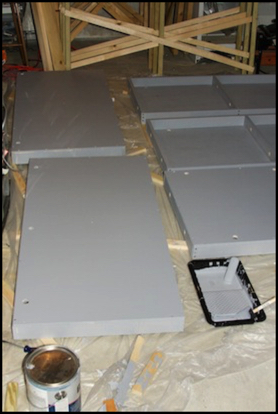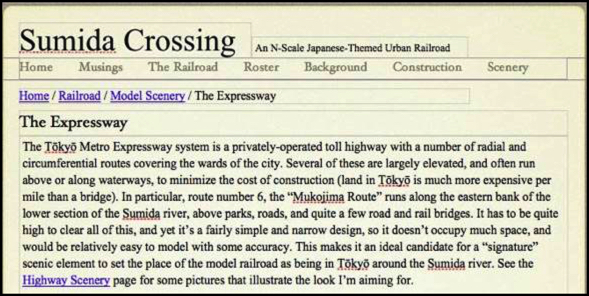Sumida Crossing at Five

Five years? It’s really been five years since I started this layout? My how time has flown. But it has: the photo above shows the layout on August 29, 2009. Just a pile of boards and 2x4 plywood panels leaning against my workbench, plus the old blue-painted hardboard backdrops from my previous layout.
I’d become interested in Japanese trains a couple of years previously, and had been playing with a few of them on my Kitchen Table with a loop of Kato Unitrack. My first two trains were a Yamanote Line E231-500 (six car basic set) and the original Narita Express (253 Series, also six cars). By the spring of 2009 I had a half-dozen trains and I was thinking that it was time to retire the old HO layout, which had been collecting dust for a number of years, and build something in its place. Planning began, and by late July I was taking the old layout apart.
Then one weekend in late August, I decided that my plans were solid enough to take saw to plywood. An afternoon at the local home supply store and I was equipped with the lumber I needed to start making my 2x4 “tables”. They went together even faster than expected, eight of them in a bit more than a week, and soon I had them spread out over the basement floor on sheets of plastic, being painted with gray latex primer.

Painting the Tables (benchwork in the rear)
On my previous layout, and a few that never made it out of the design stage, I’d kept my notes on paper in a three-ring binder. As I worked, I’d been collecting notes: some on paper, but most on my computer. It soon became clear that I would be doing most of my research online rather than buying books as I had for North American railroads. And while I could keep the notes on the computer just as they were, Apple had recently come out with iWeb, which made web site creation and publishing trivial. And that convinced me to keep my notes as an “online notebook” using iWeb and publish them so others could see the information I’d collected.
I started that in mid-September, but I didn’t actually get around to getting a domain name and putting the website online for a couple more months. In fact, it was over the Thanksgiving weekend holiday in late November that I finally found the time to do it, and on 29 November this site went live. I don’t think anyone was reading it though. It wasn’t until late January that I finally signed up for an account on the JNS Forum, and told people about my layout and the website.

The original iWeb version: simple text and graphics on a page, with a short header
It’s been an interesting five years. Work on the layout was steady if slow for the first couple of years. The benchwork was essentially done by January 2010, and scenic work began then. This is also when I started to realize some of the design mistakes I’d made. Some I could fix easily, like replacing the Kato viaduct station on their plastic supports with something more solid made from threaded steel rods holding up aluminum carpet trim that in turn supported a hardboard station deck, or repainting (and later adding photos to) the backdrops.
But some, like the placement of track too near the backdrop in several places, or the light rail line that was invisible behind and under the urban station, were not going to be fixed without a major rebuild, so I lived with them.
And then I started the big switch from DC to DCC, and discovered that I’d made a lot of extra work for myself though some of the choices I’d made. I still think some of them were right, like having a lot of electrically-isolated blocks with local circuit breakers, and lots of occupancy detection. But using electronics that required a lot of soldering rather than using screw terminals was a mistake. And my choice of Digitrax’s “transponding” was a major error: it never worked properly, probably because of the low current draw of the SMD LED lighting on typical N-scale motor cars.
And at that point, I really lost interest in working on the layout. Not on running trains: I kept running trains on my outer double-track oval with DC power and occasionally DCC as that line was set up without circuit breakers (other than the one in the command station) and with no occupancy detectors, so I had it all working. But despite a couple of short-lived bursts of activity on scenery or other details, work on the layout itself stopped. That should have clued me in.
More and more I busied myself on either other layouts like the never-completed urban tram line layout, which is collecting dust in my living room, or the one-point five meter line that’s still awaiting track-laying, as well as side projects like playing with DC motors, or on building structures or investigating various interesting model railroading topics (like DC motor behavior).
And when Apple retired iWeb, I was able to distract myself for six months with converting over 200 pages (I type too much) from it into the new system (Rapidweaver), basically rewriting all of them as I went. I’d never been entirely happy with iWeb, as it did some things well, but other things not at all. I spent a lot of time on CSS, JavaScript and PHP as well, things I’d never played with before, and could have skipped if I’d really wanted to, but it was fun and I could tell myself it was necessary for the website to work the way I’d originally wanted iWeb to work. That done, I went back to puttering on a number of side projects vaguely related to the layout.
But as I mentioned earlier this summer, I eventually stopped distracting myself with these and confronted the fact that I wasn’t happy with the layout I’d (mostly) built. And I began thinking of tearing it all down and starting over. I’m still not quite ready to do that, but the design bug has bit, and I now have visions of how that new layout might look like dancing through my head.
It’s still going to be months before I do anything. I’m giving myself until next summer to do design, so I don’t dive in prematurely and start cutting lumber before I know what I really want. And this time, I promise myself, I’m going to pay a bit more attention to what things will look like before I put the track down, so I don’t end up with invisible lines or trains scraping the photo-backdrop.
Five years, or even six, is a relatively short lifespan for a model railroad layout, although the Kitchen Table layout, which had no benchwork, nor scenery to speak of, only lasted two. But I don’t count it wasted. I had fun. Most of the structures will recycle into the new layout, as will all of the trains. And I learned a lot about what to do, and more importantly what not to do.
My current work, puttering along in between non-hobby activities, is mostly research: how do I want to build the physical support structure, what kind of standards will I hold myself to for trackwork, etc. That may seem a bit like putting the cart before the horse, but I want to understand what limits I’ll have before I invest too much time on coming up with things to include in the layout.
I am starting to think about what “scenes” I want in the new layout, and how to structure them. But my chosen location of the greater Tōkyō metropolitan area has far more railroading in it than any layout could hope to show, even compressed. Even limiting myself to the things I most want to model, I’ll probably end up with more than I have room for, but that’s okay. The idea is to figure out what I don’t know by trying to design them, and what they’ll need in terms of space and supporting structure. Then I can pick the ones I want most that will fit in available space, using the constraints of track and structure I’ve determined.
I have a reasonable handle on the benchwork, although there are still things I need to think about there. And while I’ve mostly settled on using Peco Code 55 track, I have some tracklaying experiments I want to try (there’s a sheet of plywood and some flex track in my basement awaiting some spare time) to see how well it looks and works.
As I said before, the next year is for planning. If I start building before next August, I’ll be mildly surprised. But for now I still have the working parts of the old layout to play with. And if I take the time to think this through, the next five years should be more productive than the last, and hopefully the new layout will have a longer lifespan.



